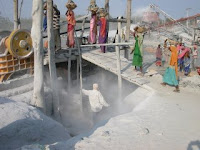The AP published a seemingly blistering report the perceived politicization of the agency over the last eight years.
In early 2001, an epidemiologist at the Occupational Safety and Health Administration sought to publish a special bulletin warning dental technicians that they could be exposed to dangerous beryllium alloys while grinding fillings. Health studies showed that even a single day's exposure at the agency's permitted level could lead to incurable lung disease.To be fair, throughout the article administration officials are quoted as saying that listening to corporate voices ensured that the agency did not hurt the country's economic competitiveness. While I agree that corporations large and small deserve a seat at the table when any regulation that may affect them is being debated, it's hard to understand, however, why they were the only voice on so many occasions. Read the full report, "Indecision and Delay Characterized Bush's OSHA".
After the bulletin was drafted, political appointees at the agency gave a copy to a lobbying firm hired by the country's principal beryllium manufacturer, according to internal OSHA documents. The epidemiologist, Peter Infante, incorporated what he considered reasonable changes requested by the company and won approval from key directorates, but he bristled when the private firm complained again.
